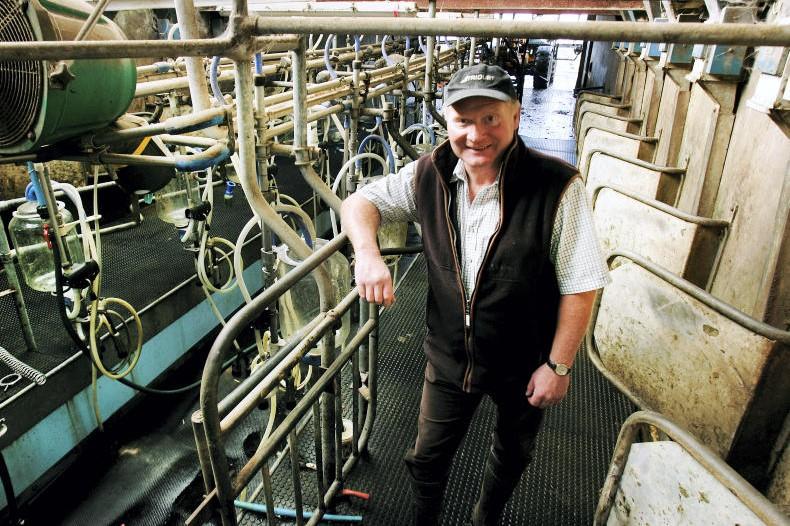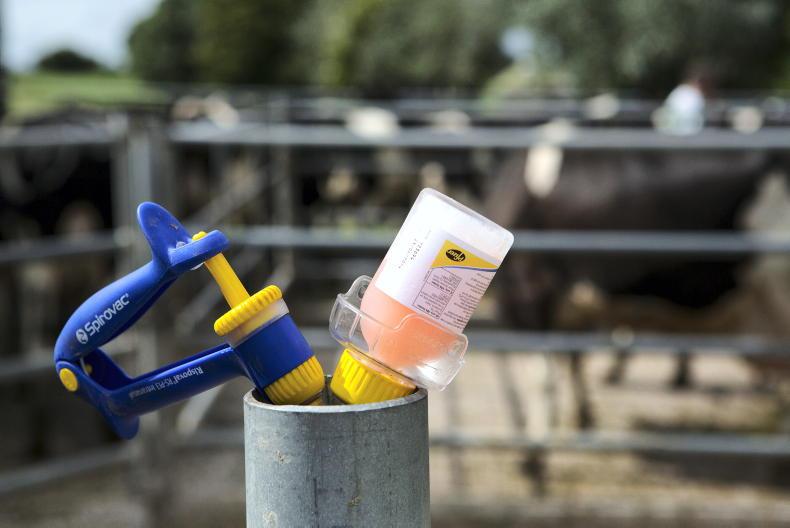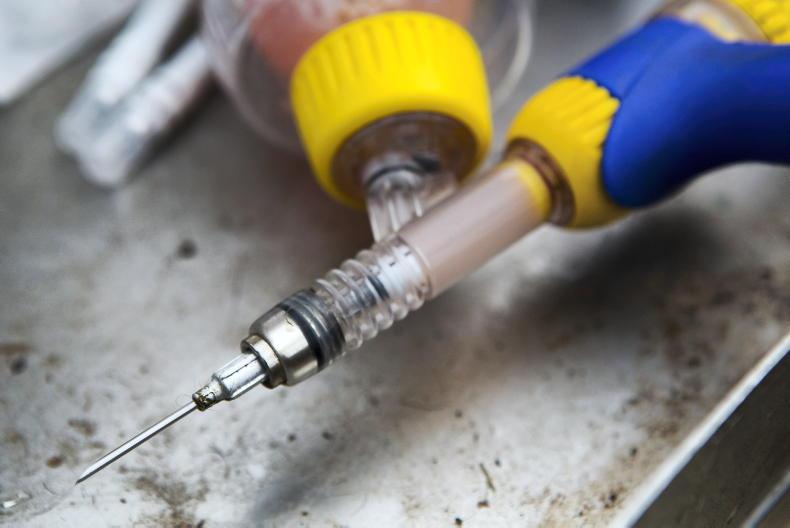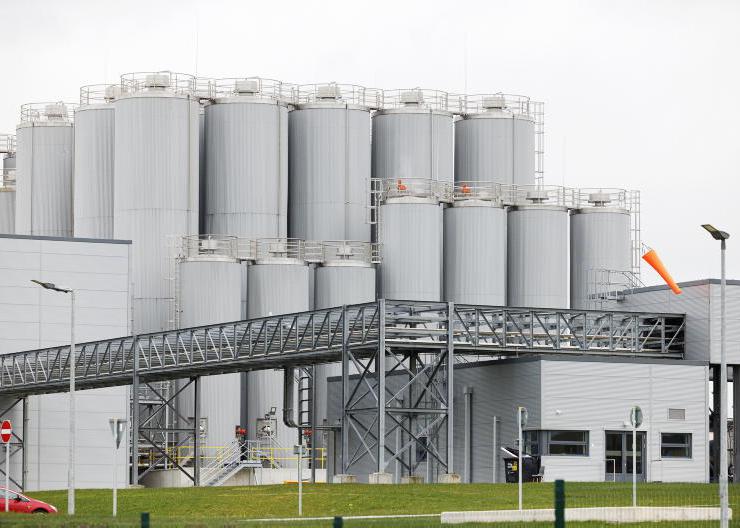Co Antrim dairy farmer James King was able to cut his meal bill last year, while delivering an increase in milk yield.
A review of physical and financial benchmarking figures by Dairylink Ireland adviser Aidan Cushnahan found that James had an average concentrate feed rate of 0.36kg/l in 2019.
Compared to the 0.40kg/l achieved the year before, this shows that feed efficiency is moving in the right direction on the King farm.
As Figure 1 shows, concentrates are the single biggest cost to the business, worth 38% of farm working expenses.
Aidan calculates that last year’s improvement in feed efficiency delivered James a meal bill saving of £10,734. This was calculated by applying the 2018 feed rate of 0.40kg/l to last year’s production levels.
Table 1 shows that the King herd averaged 7,444l/cow in 2019, which is up by 1.8% year-on-year.
Total concentrate fed per cow was back by 5.6% and stood at 2,680kg last year. Milk from forage subsequently increased by almost 500l to 1,488l/cow.
The average milk price James received last year was down 1.7p/l on 2018 levels to 27.2p/l. This meant that, despite improvements in feed efficiency, margin over concentrate (milk cheque minus meal bill) reduced last year by £51/cow to £1,355/cow.

The low yielders on the King farm have been at grass by day since 4 March.
However, Aidan points out that if feed rates had remained unchanged at 0.40kg/l, last year’s margin over concentrate would have been down another £59/cow, equating to £1,296/cow.
Improvement
The main improvement in feed efficiency on the King farm came from getting more milk from grazed grass during the spring and summer months.
James started measuring and budgeting grass last year, which helped maintain sward quality and lower concentrate feeding.
In previous years, the high stocking rate usually meant that additional fodder had to be bought in
Another key change on the King farm was switching from a closed herd to a flying herd system, where replacements are bought in. Although this requires a more stringent approach to animal health to avoid buying in disease problems, a flying herd has allowed savings with labour.
It has also allowed James to reduce his stocking rate while increasing cow numbers and subsequent milk output. In previous years, the high stocking rate usually meant that additional fodder had to be bought in, which added to feed costs.
Finances
After concentrates, machinery running costs were the second-largest cost and amounted to £28,678, while the fertiliser and lime bill came to £22,273.
Overall, the main farm working expenses totalled £291,448 (23.4 p/l) last year on the King farm.
Total income, excluding Basic Payment, was £383,382 during 2019. When a standardised figure of £30,000 is applied for personal drawings, then the business would have had £61,934 available for loan repayments, capital expenditure and tax.
Looking forward
Feed efficiency is being benchmarked monthly on the King farm and is proving useful for identifying where further improvements can be made.
Dairylink adviser Aidan Cushnahan uses February 2019 as an example, when milk from forage was -0.7l/cow/day. This was mainly due to James having to feed higher levels of concentrates last spring to prevent a potential fodder shortage on the farm.
The low yielders have been at grass by day since 4 March
To avoid overfeeding cows with concentrates this year, he has split the milking herd into high and low-yielding groups, so that meal can be targeted at the cows that will respond with increased milk yields. The low-yielding group is made up of cows that are producing less than 25l/day and are scanned in-calf.
The low yielders have been at grass by day since 4 March and there have been no adverse impacts on production. This group of 60 cows is currently averaging 19.3l/cow/day at 4.95% butterfat and 3.71% protein from 5kg of concentrates. Having these cows out at grass also reduces demand on fodder and means James is less reliant on feeding fourth-cut silage to the milking herd. This fodder is below-average quality, with an metabolisable energy content 9.7MJ/kgDM.
Aidan points out that there are other opportunities to produce more milk from grass in the coming months. Monthly benchmarking figures indicate that from April to June 2019, milk from forage levels varied from 10.95l/cow/day to 16.21l/cow/day, while margin over concentrate sat between £4.94/cow/day and £5.92/cow/day.
Aidan calculates that if milk from forage had been 3l/cow/day higher over this period, the improvement in feed efficiency would have generated a meal bill saving of £4,912, if milk yields stayed at the same levels.
Adviser comment – Aidan Cushnahan
Putting low-yielding cows to grass and reducing concentrates in the parlour is the main way of producing milk more efficiently on dairy farms. There is no point feeding an extra four-kilo of meal to stale cows at a price of 24p/kg, if the only response is another 2l of milk.
Read more
Dairylink Ireland: improving feed efficiency in Down
Signs of spring on Dairylink farms
Co Antrim dairy farmer James King was able to cut his meal bill last year, while delivering an increase in milk yield.
A review of physical and financial benchmarking figures by Dairylink Ireland adviser Aidan Cushnahan found that James had an average concentrate feed rate of 0.36kg/l in 2019.
Compared to the 0.40kg/l achieved the year before, this shows that feed efficiency is moving in the right direction on the King farm.
As Figure 1 shows, concentrates are the single biggest cost to the business, worth 38% of farm working expenses.
Aidan calculates that last year’s improvement in feed efficiency delivered James a meal bill saving of £10,734. This was calculated by applying the 2018 feed rate of 0.40kg/l to last year’s production levels.
Table 1 shows that the King herd averaged 7,444l/cow in 2019, which is up by 1.8% year-on-year.
Total concentrate fed per cow was back by 5.6% and stood at 2,680kg last year. Milk from forage subsequently increased by almost 500l to 1,488l/cow.
The average milk price James received last year was down 1.7p/l on 2018 levels to 27.2p/l. This meant that, despite improvements in feed efficiency, margin over concentrate (milk cheque minus meal bill) reduced last year by £51/cow to £1,355/cow.

The low yielders on the King farm have been at grass by day since 4 March.
However, Aidan points out that if feed rates had remained unchanged at 0.40kg/l, last year’s margin over concentrate would have been down another £59/cow, equating to £1,296/cow.
Improvement
The main improvement in feed efficiency on the King farm came from getting more milk from grazed grass during the spring and summer months.
James started measuring and budgeting grass last year, which helped maintain sward quality and lower concentrate feeding.
In previous years, the high stocking rate usually meant that additional fodder had to be bought in
Another key change on the King farm was switching from a closed herd to a flying herd system, where replacements are bought in. Although this requires a more stringent approach to animal health to avoid buying in disease problems, a flying herd has allowed savings with labour.
It has also allowed James to reduce his stocking rate while increasing cow numbers and subsequent milk output. In previous years, the high stocking rate usually meant that additional fodder had to be bought in, which added to feed costs.
Finances
After concentrates, machinery running costs were the second-largest cost and amounted to £28,678, while the fertiliser and lime bill came to £22,273.
Overall, the main farm working expenses totalled £291,448 (23.4 p/l) last year on the King farm.
Total income, excluding Basic Payment, was £383,382 during 2019. When a standardised figure of £30,000 is applied for personal drawings, then the business would have had £61,934 available for loan repayments, capital expenditure and tax.
Looking forward
Feed efficiency is being benchmarked monthly on the King farm and is proving useful for identifying where further improvements can be made.
Dairylink adviser Aidan Cushnahan uses February 2019 as an example, when milk from forage was -0.7l/cow/day. This was mainly due to James having to feed higher levels of concentrates last spring to prevent a potential fodder shortage on the farm.
The low yielders have been at grass by day since 4 March
To avoid overfeeding cows with concentrates this year, he has split the milking herd into high and low-yielding groups, so that meal can be targeted at the cows that will respond with increased milk yields. The low-yielding group is made up of cows that are producing less than 25l/day and are scanned in-calf.
The low yielders have been at grass by day since 4 March and there have been no adverse impacts on production. This group of 60 cows is currently averaging 19.3l/cow/day at 4.95% butterfat and 3.71% protein from 5kg of concentrates. Having these cows out at grass also reduces demand on fodder and means James is less reliant on feeding fourth-cut silage to the milking herd. This fodder is below-average quality, with an metabolisable energy content 9.7MJ/kgDM.
Aidan points out that there are other opportunities to produce more milk from grass in the coming months. Monthly benchmarking figures indicate that from April to June 2019, milk from forage levels varied from 10.95l/cow/day to 16.21l/cow/day, while margin over concentrate sat between £4.94/cow/day and £5.92/cow/day.
Aidan calculates that if milk from forage had been 3l/cow/day higher over this period, the improvement in feed efficiency would have generated a meal bill saving of £4,912, if milk yields stayed at the same levels.
Adviser comment – Aidan Cushnahan
Putting low-yielding cows to grass and reducing concentrates in the parlour is the main way of producing milk more efficiently on dairy farms. There is no point feeding an extra four-kilo of meal to stale cows at a price of 24p/kg, if the only response is another 2l of milk.
Read more
Dairylink Ireland: improving feed efficiency in Down
Signs of spring on Dairylink farms










SHARING OPTIONS